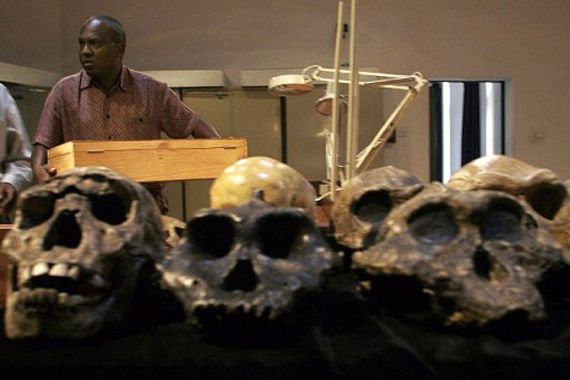New fossils point to ‘more human species’
Fossils found in Kenya show there were two additional pre-human species besides Homo erectus, researchers say.

Three new fossils have been found in Kenya which show that there are two additional pre-human species besides the one that eventually led to modern humans, researchers say.
A team led by Meave Leakey, daughter-in-law of famed scientist Louis Leakey, found facial bones from one creature and jawbones from two others in northern Kenya that led the researchers to conclude that man’s early ancestor had plenty of human-like company from other species.
Keep reading
list of 4 itemsTurtles swimming to extinction in Malaysia as male hatchlings feel heat
Could shipping containers be the answer to Ghana’s housing crisis?
Thousands protest against over-tourism in Spain’s Canary Islands
The new bones were found between 2007 and 2009 about 10km away from the old site near the fossil-rich Lake Turkana region, Leakey said.
These would not be Homo erectus, believed to be our direct ancestor. They would be more like very distant cousins, who when you go back even longer in time, shared an ancient common ancestor, one scientist said.
The research has been published online on Wednesday in the journal, Nature.
But other experts in human evolution are not convinced by what they say is a leap to large conclusions based on limited evidence.
It is the continuation of a long-running squabble in anthropology about the earliest members of our own genus, or class, called Homo.
And much of it stems from a controversial discovery that the Leakeys made 40 years ago.
The scientist team says that none of their newest fossil discoveries match erectus, so they had to be from another flat-faced relatively large species with big teeth.
‘Human evolution not straight’
The new specimens have “a really distinct profile” and thus they are “something very different”, said Meave Leakey, describing the study in Nature.
What these new bones did match was an old fossil that Meave and her husband Richard helped find in 1972 that was baffling. That skull, called 1470, just did not fit with Homo erectus.
For the past 40 years, the scientific question has been whether 1470 was a freak mutation of erectus or something new.
They believe there were three living Homo species between 1.8 million and 2 million years ago. They would be Homo erectus, the 1470 species, and a third branch.
“Anyway you cut it there are three species,” study co-author Susan Anton, an anthropologist at New York University, said. “One of them is named erectus and that ultimately in our opinion is going to lead to us.”
Both of the species that Meave Leakey said existed back then went extinct more than a million years ago in evolutionary dead-ends.
“Human evolution is clearly not the straight line that it once was,” said study co-author Fred Spoor of the Max Planck Institute in Germany.
The three different species could have been living at the same time at the same place, but probably didn’t interact much, he said.
They did not name the species but two likely possibilities are Homo rudolfensis – which is where 1470 and its kin seem to belong – and Homo habilis, where the other non-erectus belong, Anton said.
But Tim White, a prominent evolutionary biologist at the University of California Berkeley, is not buying this new species idea, nor is Milford Wolpoff, a longtime professor of anthropology at the University of Michigan.
They said the Leakeys are making too big a jump from too little evidence.